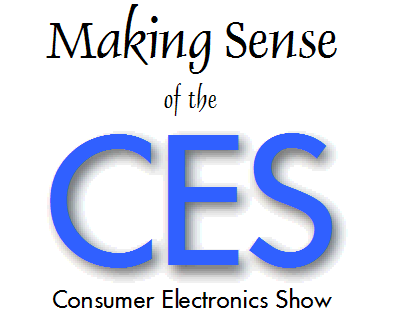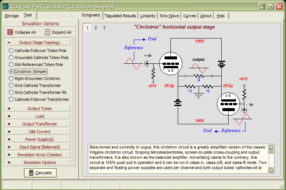| John Broskie's Guide to Tube Circuit Analysis & Design |
10 January 2005
When I looked out at Vegas from my window on the airplane, I thought to myself, “Mercy, this place is huge.” But once on the ground, I am sure I only saw 0.01% of the city, in spite of getting lost several times. Still, I traveled through the heart of beast and I saw what Vegas wants everyone to see: the city painted with electricity and the wholesale abandonment of all shame and taste. Whoever said “Las Vegas is what you would get if you let the Mafia design Disneyland” was right. At night the sky never grew dark because the cloud cover reflected the lights below, almost as if the sun had not set in the horizon, but had fallen into the center of the city. Ironically enough for a place that claims to be courting the tourist dollars of families with young children, the backs of buses were routinely adorned with large ads displaying female posteriors, otherwise naked, but saved from indecency by the amazing concealing properties of G-strings. And of course, no mention of Las Vegas would be complete without the gambling, which the city fathers politely and exclusively refer to as “gaming.” Slot machines were so ubiquitous that while I didn’t intrude into the solemnity of a mortuary, I would have been shocked not to find one there too. So where else would you hold the Consumer Electronics Show, but Vegas? Salt Lake City? Too tight. Detroit? Too scary. New York? Too expensive. San Francisco? Too small. LA? Too…just too obvious a choice, perhaps, due to the presence of Hollywood's movie machine. No, Las Vegas best suits the show, as it is the least real, most electric city in America, which perfectly suits the business of making the unreal—impalpable images and sounds incorporeal—believable through electricity. Blue and the Blues Now I know why many states prohibit the use of blue lights on cars other than police cars; the concern is not safety, but sanity. At first it was like the first sight of a new fashion in a magazine: perhaps charming, maybe striking, possibly alluring, but by the end of show—like at the end of a fad’s run, when everyone has adopted the super-flared pants or ultra-wide lapels—it was just fatiguing. And it wasn’t just high-end gear that glowed blue. At the big exhibit hall (the CES zoo proper), befitting a K-Mart special, many of the small cheesy companies tarted up their dreck with blue lights (several of which I’m sure were cheaply produced by blue light bulbs, rather than expensive blue LEDs). I was reminded of how the new fashion fad starts brilliantly with runway models in glossy ads and ends bleakly on runaways turned hookers standing on street corners. Basically, I got the blues after seeing so much icy blue, longing for some warm amber or cool wintergreen. Speaking of the blues, the blues played through the hallways, as room after room spinned the same blues CDs. Moving through the hallways was like listening to a best-of-Stevie-Ray-Vaughn CD. Blues and more blues. Even the erstwhile popular “Famous Blue Raincoat” mournfully played in one room. At least the blues held a few acoustic instruments, whereas pure synthetic pop blared in too many rooms, the sort of music that no one would ever listen to had the demo disk not been invented. Occasionally classical music made an appearance, and I longed for more of it, or anything purely acoustic, really. LPs & Tape The sound wasn’t always pretty; but at its best, it was the best, although half-inch tape did make a strong showing at deHavilland's room. I have to admit that I know and like George Kielczynski, the owner of deHavilland, but I have no qualms in saying that I was quite impressed with the sound comming out of the his deHavilland GM70 amplifiers. Sure there was some hiss on the tape, but there was something alive about the music playing that startled me. (Remember when the CD didn’t exist and master tapes were universally held in the highest regard. Well, that regard was well founded, as tape can sound just fabulous.) Tubes? At the high-end portion of the CES show, at least half the rooms sported tube gear. And at "T.H.E. (The Home Entertainment) Show" held next door to the CES high-end audio venue, the ratio was probably higher. I was wowed by quite a few efforts; and even when the sound was pedestrian, it was pleasingly pedestrian. On the other hand, when the solid-state gear wowed, it still wasn’t that pleasing, which in a nutshell explains my preference and prejudice. (One thought that cross my mind was that in spite of the bluster and optimism of the show's exhibitors, most of what I saw would fail, the new product dropped; the business, out of business. How companies were first-time exhibitors? How many held their last exhibit? A morbid thought. Yet, if I were to spend $5,000 on something shinny and new, I would prefer knowing that if broke in three years, fixing it would be possible, that I, if no one else, could trace the circuit and make the repairs. Obviously, tube gear is much easier to repair than solid-state gear, particularly the surface-mount laden gear, as I cannot imagine myself being able to fix a micro PCB. Of course, when the shinny new object only $100, we throw it away when it breaks, but who wants to throw away a $5,000 preamp. Long term, tubes make a lot of sense.) Hybrid amplifiers FAL showed an impressive hybrid, the final: a solid-state preamp and power amplifier that used tube rectifiers in the deacated power supply. Not one tube rectifier or two, but sixteen of them! Aurum Acoustics produced some of the most civilized, refined, and ear-pleasing sounds that I heard at the show. How did they do it? 300Bs, four in fact, one per amplifier. The Integris Active 300B is a system of loudspeakers and an SE amplifier for each tweeter and midrange, with an internal high-quality solid-state amplifier sourced from Bryston for each woofer. In other words, no crossover within the speakers, as the crossover is built in the amplifier chassis. Because the tweeter amplifier will sledom be asked to clip, the sound from the SE 300B is greatly magnafied, sounding more like 200W monoblocks. At $30,000 CDN, this system is not cheap, but it was splendid. All-tube amplifiers One interesting trend is the small-refrigerator-sized amplifiers. They stand between two to three feet tall and are about 18 inches wide and two feet deep—and as much as a nice sedan. Sometimes they hold 12 6550s, as in the VTL Siegfried amplifiers ($40,000) or a pair of 845s, as in the Zanden Audio Systems Model 9500 ($39,970) or a single 833, as in the AAP T833M amplifier by Phil Jones. At the other extreme, PrimaLuna won the best bang-per-buck contest, in my opinion. These are beautifully made tube amplifiers that sound great and cost little ($1,095). Before building any amplifier pause and consider if it can do as much as these amps at a lower price. The worst idea prize Now, I do not like to pan any piece of audio that I hear sound bad at a show; there are too many variables at play top ever say that all the blame lies with one component. If a component sounds good, then it must be good; but if it sounds bad, it might not be. For example, one brand of speakers that I hold in the highest regard, sounded downright mediocre in the room the loudspeaker company had set up; but in another room that featured power amplifiers, they sounded, just as expected, fabulous. But these cables are in a class by themselves and I cannot think of a better punishment for their creator than to force him to listen to exclusively for the rest of his life. Just dreadful. Best surprise The first listening of these tall, slender, well-made speakers could hardly been worse for the loudspeakers, as defective equipment powered them. Nonetheless, in spite of gross distortion, there was something very right about these loudspeakers. My second encounter with them erased every sour note from my memory. These loudspeakers perform at level that I would expect to cost three times more. They image; they fill the room with tight bass and effortless highs; they just don’t sound like an assemblage of woofers, midranges, and tweeters. Had a tall electrostatic-looking screen been place in front of them, I would easily believed that they were electrostatic loudspeakers with a smooth top end. What makes them special? My guess is clear thinking and careful engineering. The tweeter is horn loaded and time aligned with the midrange. A single spike into the floor works to ground the cabinet vibrations into a single point, like a star ground in an electrical circuit. Best technical conversation Here is an example of how valuable consistent imperfection can be: say you live on the 22nd floor of an apartment building and the elevator buttons are consistently off by five floors, so everyday you must press the button for floor 27 to get to floor 22. You quickly adapt and find no problem in it except when company comes and you need to remember to tell them the "trick." On the other hand, an elevator that was less imperfect, but less consistent, would be a much bigger headache—for example, say that its buttons were off by either one floor too high or on the money or one floor too low. Such an elevator would be maddening to operate, as you could not easily compensate for its imperfection, taking many tries to get to your floor. Michael has cataloged and mapped the transistor’s imperfections and he has devised techniques to compensate for them in an almost Aikido-like fashion. Most transistor-amplifier designers have a simple solution: more feedback; period. His approach requires a much greater understanding and skill, but the result is a sweet sounding, dual mono, class-A, power amplifier that only cost $1,695. I was impressed.
//JRB |
TCJ Push-Pull Calculator TCJ PPC Version 2 Improvements Rebuilt simulation engine *User definable
Download or CD ROM For more information, please
visit our Web site : | |||
| www.tubecad.com Copyright © 1999-2005 GlassWare All Rights Reserved |
















